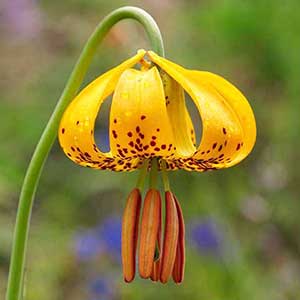Lilium columbianum
Lilium parryi
Columbia lily, Columbia tiger lily, Columbian lily, Oregon lily, tiger lily
lemon lily, Parry lily
variable, subrhizomatous to ± ovoid, 3.1–8.1 × 3.6–10.6 cm, 0.3–1.4 times taller than long;
scales 2–3(–5)-segmented, some unsegmented, longest 3.1–7.3 cm;
stem roots absent.
rhizomatous, unbranched, continuously scaly, 1.5–4.7 × 3.5–11 cm, 0.2–0.6 times taller than long;
scales (1–)2(–4)-segmented, longest 0.9–3.7 cm;
stem roots absent.
to 1.7 m, glaucous or not.
to 1.9 m.
rounded in cross section.
rounded in cross section.
in 1–9 whorls or partial whorls, 3–25 leaves per whorl, usually ascending, 1.7–15.7 × 0.4–4.7 cm, 2.4–7.4 times longer than wide;
blade weakly oblanceolate to obovate or ± elliptic, margins usually somewhat undulate, apex acute;
veins and margins ± smooth abaxially.
occasionally scattered in young plants or in 1–5 whorls or partial whorls, 3–18 leaves per whorl, ± horizontal and drooping at tips or ascending, 7.8–29 × 0.5–4.9 cm, 2.6–29 times longer than wide;
blade elliptic to narrowly linear, or ± obovate, often lanceolate in distal leaves, margins not undulate, apex acute, often narrowly so;
veins and margins ± smooth abaxially.
racemose, 1–25(–45)-flowered.
racemose, 1–31-flowered.
pendent to nodding, not fragrant;
perianth Turk’s-cap-shaped;
sepals and petals reflexed 2/5–1/2 along length from base, yellow or orange to occasionally red, with copious maroon spots, often darker and especially reddish abaxially, not distinctly clawed;
sepals not ridged abaxially, appearing wide for their length, 3.4–7.1 × 0.8–1.9 cm;
petals 3.5–6.9 × 0.8–1.9 cm;
stamens barely to moderately exserted;
filaments moderately spreading, diverging 10°–20° from axis;
anthers pale yellow to yellow, 0.5–1.3 cm;
pollen orange or yellow;
pistil 2.4–3.7 cm;
ovary 1.1–2.2 cm;
style green;
pedicel 2.8–20.2 cm.
opening before dusk, horizontal or somewhat nodding, slightly bilaterally symmetric, strongly fragrant;
perianth funnelform;
sepals and petals recurved 3/5 along length from base, lower less recurved than upper and forming landing platform, bright yellow with sparse, usually minute maroon spots, not distinctly clawed;
sepals not ridged abaxially, oblanceolate, 7.7–10.7 × 1.1–1.7 cm;
petals noticeably wider than sepals, often very wide distally, 7.8–10.6 × 1.1–2.1 cm, apex widely acute or sometimes obtuse;
stamens barely exserted;
filaments barely spreading, diverging at 5°–12°;
anthers pale magenta-brown, 0.8–1.4 cm;
pollen rust-orange or orange-brown;
pistil 5.3–9.3 cm;
ovary 1.6–2.9 cm;
style green, often pale;
pedicel 2–17.5 cm.
2.2–5.4 × 1.1–2 cm, 1.7–3.3 times longer than wide.
3.9–5.9 × 1.1–1.7 cm, 2.5–4.4 times longer than wide.
135–330.
141–303.
= 24.
= 24.
Lilium columbianum
Lilium parryi
The author citations often seen for this species derive from Baker (1874), who published the name as Lilium columbianum “Hanson in hort., Leichtlin”; this authority is given by various later writers as Hanson, or Baker, or Hanson ex Baker. However, Ducharte’s (1871) recapitulation of a letter from M. Leichtlin is apparently the first confirmed and valid publication of L. columbianum, and hence that citation is used here.
This widespread lily is rather variable. In California plants the stamens are considerably less exserted than those of plants found farther north. Lilium columbianum may intergrade with L. kelloggii along Highway 199 at the border between California and Oregon; these plants are slightly fragrant, the stamens moderately exserted, and the bulb scales unsegmented. Lilium columbianum hybridizes with L. pardalinum subspp. wigginsii and vollmeri, and extensively with L. occidentale in Oregon.
Lilium columbianum is pollinated primarily by rufous hummingbirds [Selasphorus rufus (J. F. Gmelin), family Trochilidae] and to a lesser extent by large butterflies, including the pale swallowtail (Papilio eurymedon Lucas, family Papilionidae).
Native Americans used Lilium columbianum bulbs as a food or peppery condiment, sometimes mixed with meat or salmon roe. For many, it was a staple food (J. Pojar and A. MacKinnon 1994).
(Discussion copyrighted by Flora of North America; reprinted with permission.)
Plants in Arizona start to bloom in May (T. H. Kearney and R. H. Peebles 1960), while the majority of California plants flower in July and August.
Plants from the San Gabriel Mountains of California sometimes have wider leaves and have been given status as Lilium parryi var. kessleri, but this variation is due primarily to the rather shaded habitat of many of these populations. No significant vegetative discontinuity can be recognized across the range of this species, so no varieties are recognized here.
Lilium parryi probably arose from an ancestor in common with L. pardalinum (M. W. Skinner 1988), and subsequently diverged to become pollinated by various hawkmoths (family Sphingidae). The flowers are remarkably similar in form and function to those of L. washingtonianum, which is also moth-pollinated, but this resemblance is due to evolutionary convergence.
(Discussion copyrighted by Flora of North America; reprinted with permission.)
- Local floras:
BC,
CA,
OR,
WA
- Local Web sites:
CalFlora,
CalPhotos,
Flora NW,
PNW Herbaria,
Turner Photog.
WildflowerSearch
iNaturalist (observations)
USDA Plants Database
- LBJ Wildflower Center
- SEINet
- Plants of the World Online
- Encyclopedia of Life
- Wikipedia
- Google Image Search


